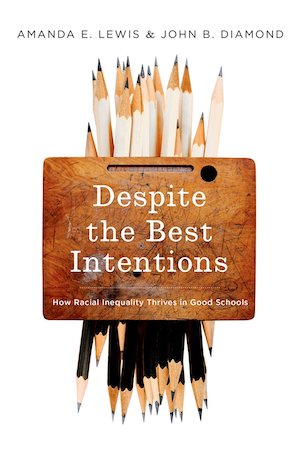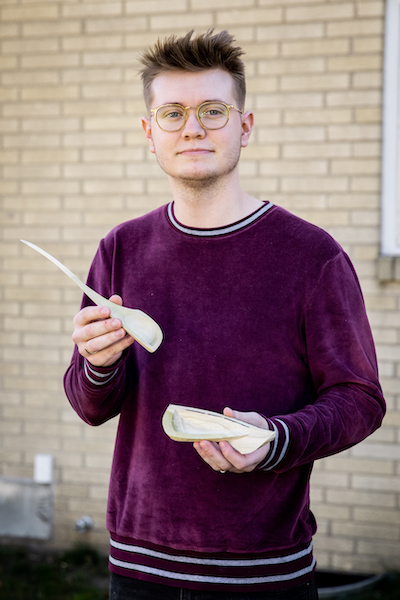John Diamond and Amanda Lewis’ book, “Despite the Best Intentions: How Racial Inequality Thrives in Good Schools,” focuses on persisting inequities in one suburban school district. Now, through a series of online study groups, the book has become a tool for constructive change for dozens of school districts and hundreds of educators from throughout Wisconsin.
A sociologist of race and education, Diamond is the Kellner Family Distinguished Chair in Education with the School of Education’s Department of Educational Leadership and Policy Analysis. Lewis is a professor at the University of Illinois at Chicago, and director of the Institute for Research on Race and Public Policy.

Diamond was inspired to do the research that underlies “Despite the Best Intentions” when he was approached by an administrator from a suburban district in the Midwest who wanted to understand why different outcomes by race were so prevalent in his school.
“The challenge was that while the school had a lot of resources and was racially diverse,” Diamond said, “there were still big gaps in the classes students were taking, the grades they were receiving, the test scores they were get- ting, and the colleges they were going to.”
So Diamond set out with Lewis to find out what was going on. “Despite the Best Intentions” includes the results of over five years of interviews and data-gathering in the school, offering a “rich and disturbing portrait” of why racial inequities persist even in the best of circumstances.
“Despite the Best Intentions” attracted the attention of educators in Sun Prairie, Wisconsin, who then contacted colleagues at the Wisconsin Public Education Network, who worked with them to organize the book study group discussions this past summer.
About 270 people from over 30 urban, suburban, and rural school districts in Wisconsin participated.
The goal for the sessions was to disrupt people’s way of thinking; to make them aware of their biases and how they reflect in the way they treat students, how they discipline them, and what they expect of them; and to encourage them to commit to changing their practices.
 Tasha O’Malley, a Sun Prairie teacher who helped develop the questions used by 29, small-group facilitators — also educators — to guide the discussions said that they focused around helping participants “dig deep into their own racial consciousness and teaching practices.”
Tasha O’Malley, a Sun Prairie teacher who helped develop the questions used by 29, small-group facilitators — also educators — to guide the discussions said that they focused around helping participants “dig deep into their own racial consciousness and teaching practices.”
“What winds up happening is most white teachers have never thought about what it means to be white,” Diamond said. “Therefore, they are going about their business assuming that their belief systems, and ideas, and ways of working are normal and just the way things are, when in fact they are very much tied to their own racial identity.”
A majority of the study group participants were white, as are over 80 percent of educators in Wisconsin and nation- ally. Given those numbers, Diamond noted that “it is incumbent on (white educators) to have these conversations.”
Diamond and Lewis are working on a second edition of “Despite the Best Intentions,” which will be published in 2021.
Said Maggie Gugel, another Sun Prairie teacher who helped organize the study groups, about how participating in the discussions has influenced her work: “Equity is now my first thought when designing and implementing learning experiences.”
She said she hopes the book study experience will be a “spark for real change throughout the state.”
Wood program reimagines what’s possible during pandemic
After UW–Madison started the 2020 fall semester with a mix of in-person, online, and hybrid classes, a jump in the number of positive COVID-19 cases across the campus community led the university to pause in-person instruction from Sept. 10 to 25.
But thanks to the adaptability and creativity of units around UW–Madison and the School of Education, this abrupt change didn’t mean an end to high-quality learning opportunities for students.
As one example, students taking Art 334 (Wood- working) and Art 534 (Advanced Woodworking) through the School of Education’s Art Department were able to make the most of this one-of-a-kind fall semester.

The Art Department’s Wood program utilized funding from the School of Education to secure materials for a kit that each woodworking student could take home. These kits, which fit into a bucket, contained basic hand tools, clamps, a drill and drill bit, small saws, a carving knife, wood, and more.
When the university announced it was pausing in-person instruction in early September, Associate Professor Katie Hudnall, who leads the Wood program, took quick action. Hudnall, along with graduate student and teaching assistant Emma Senft, scrambled to quickly assemble the take-home kits over the weekend. Hudnall then orchestrated the safe distribution of these kits to students. Thomas Lees, the Introduction to Wood course’s lead instructor, was in quarantine himself when the university announced it was pausing in-person instruction. But he was able to work from home to help transition the course to online work for the next two weeks.
Even after the university’s pause on in-person instruction was lifted in late September, the woodworking classes transitioned to a hybrid modality (with weekly on- line meetings as a group, mixed in with some in-person work) because the take-home kits were such a success.
“It’s been encouraging to see that, despite all the complications and changes of modality, the students in these wood classes have been doing an excellent job staying on task and creating wonderfully detailed and creative objects,” says Lees, a wood- working lecturer with the Art Department. “I know that many teachers and students alike have been struggling with the multitude of challenges the pandemic presents to educating — I am at times among them. But these kits and the students wielding them remind me of why I enjoy teaching and woodworking so much.”
New master’s program in Learning Analytics
A new online master’s degree pro- gram in Educational Psychology, Learning Analytics option, is being offered through the School of Education’s highly regarded Department of Educational Psychology.
The program is designed to help graduates improve teaching, learning, and educational policy by harnessing the power of big data to tackle a broad range of challenges.
“Fundamentally, we’re not just creating number-crunchers. We’re teaching educators how to use powerful new tools to make a meaningful difference in students’ lives,” says David Williamson Shaffer, Vilas Distinguished Achievement Professor in the Department of Educational Psychology and the faculty director of the new program.
The program is 100 percent online and follows a cohort-based model. Cohorts begin in summer and cover 30 credits, allowing students to complete the entire master’s program in just 24 months.